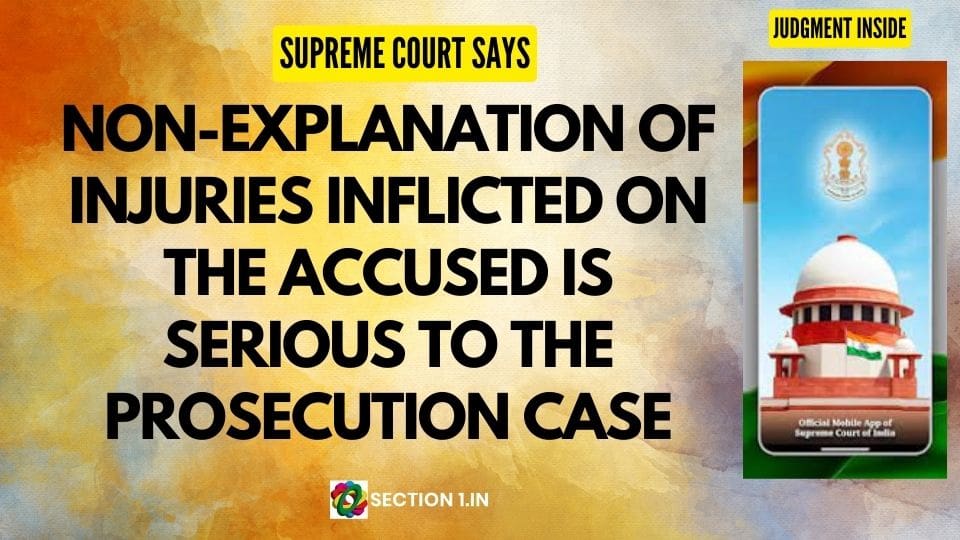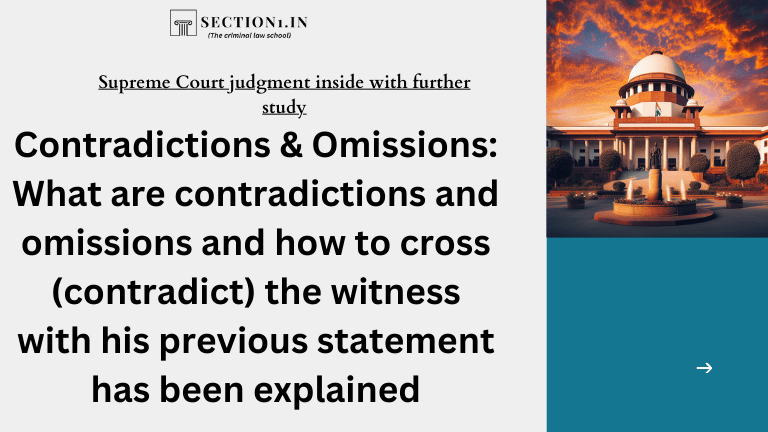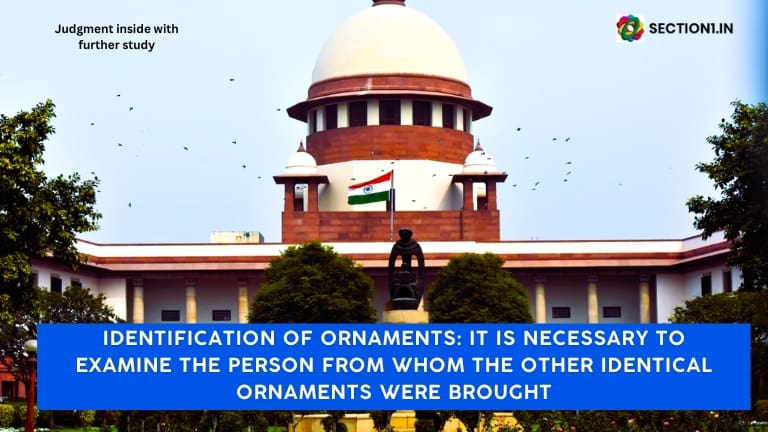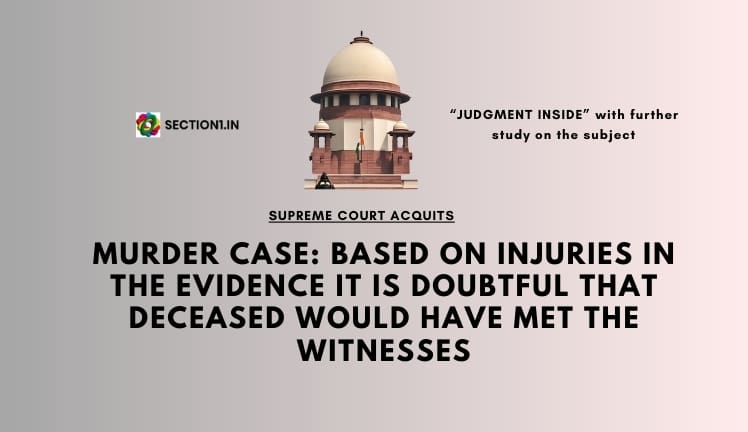FACTS
- These appeals challenge the common judgment and order dated 14th March 2018, passed by the Division Bench of the High Court of Madhya Pradesh at Gwalior, in Criminal Appeal Nos. 243 and 260 of 2005, whereby, the High Court upheld the judgment and order dated 30th March 2005, passed by the 1st Additional Sessions Judge, Shivpuri (Madhya Pradesh) (hereinafter referred to as the “trial court”) in Sessions Trial No. 09/2002, convicting the appellants and sentencing them to imprisonment for life for the offences punishable under Section 302 read with Section 149 of the Indian Penal Code, 1860 (hereinafter referred to as “IPC”), to undergo rigorous imprisonment for seven years for the offence punishable under Section 326 read with Section 149 of IPC, to undergo rigorous imprisonment for six months for the offence punishable under Section 324 read with Section 149 of IPC, to undergo rigorous imprisonment for three months for the offence punishable under Section 323 read with Section 149 of IPC, and to undergo rigorous imprisonment for three months for the offence punishable under Section 148 of IPC.
xxx
SECTION 149 IPC – EXPLAINED
- The law with regard to conviction under Section 302 read with Section 149 of IPC has been succinctly discussed by a Constitution Bench of this Court in the locus classicus of Masalti v. State of U.P. [[1964] 8 SCR 133], wherein this Court observed thus:
“17. …….What has to be proved against a person who is alleged to be a member of an unlawful assembly is that he was one of the persons constituting the assembly and he entertained along with the other members of the assembly the common object as defined by Section 141 IPC. Section 142 provides that whoever, being aware of facts which render any assembly an unlawful assembly, intentionally joins that assembly, or continues in it, is said to be a member of an unlawful assembly. In other words, an assembly of five or more persons actuated by, and entertaining one or more of the common objects specified by the five clauses of Section 141, is an unlawful assembly. The crucial question to determine in such a case is whether the assembly consisted of five or more persons and whether the said persons entertained one or more of the common objects as specified by Section 141. While determining this question, it becomes relevant to consider whether the assembly consisted of some persons who were merely passive witnesses and had joined the assembly as a matter of idle curiosity without intending to entertain the common object of the assembly. It is in that context that the observations made by this Court in the case of Baladin [AIR 1956 SC 181] assume significance; otherwise, in law, it would not be correct to say that before a person is held to be a member of an unlawful assembly, it must be shown that he had committed some illegal overt act or had been guilty of some illegal omission in pursuance of the common object of the assembly. In fact, Section 149 makes it clear that if an offence is committed by any member of an unlawful assembly in prosecution of the common object of that assembly, or such as the members of that assembly knew to be likely to be committed in prosecution of that object, every person who, at the time of the committing of that offence, is a member of the same assembly, is guilty of that offence; and that emphatically brings out the principle that the punishment prescribed by Section 149 is in a sense vicarious and does not always proceed on the basis that the offence has been actually committed by every member of the unlawful assembly……..”
- It could thus clearly be seen that the Constitution Bench has held that it is not necessary that every person constituting an unlawful assembly must play an active role for convicting him with the aid of Section 149 of IPC. What has to be established by the prosecution is that a person has to be a member of an unlawful assembly, i.e. he has to be one of the persons constituting the assembly and that he had entertained the common object along with the other members of the assembly, as defined under Section 141 of IPC. As provided under Section 142 of IPC, whoever, being aware of facts which render any assembly an unlawful assembly, intentionally joins that assembly, or continues in it, is said to be a member of an unlawful assembly.
IT IS NOT NECESSARY THAT THE MEMBER OF THE UNLAWFUL ASSEMBLY MUST HAVE ACTUALLY ASSAULTED THE DECEASED
- Undisputedly, from the evidence of Chironji (PW-6) and Ramhet (PW-12), it is clear that the present appellants were members of the unlawful assembly. No doubt that there is no specific role attributed to the present appellants of assaulting the deceased Madan. However, since the appellants were members of the unlawful assembly, in view of the law laid down by this Court in the case of Masalti (supra), it is not necessary that such a person, for being convicted, must have actually assaulted the deceased.
xxx
DEFENCE TAKEN BY THE ACCUSED WAS ‘FREE FIGHT’
- The defence taken by the appellants and the other accused persons was that in fact the accused persons had first lodged the complaint with regard to the attack made by the complainant party. It is their defence that after lodging the complaint, when they were coming back from the Police Station, the complainant party had come on a tractor and assaulted the accused persons. It is their contention that the accused persons tried to save themselves. As a result whereof, there was a free fight resulting in injuries to the members of both the parties and unfortunately deceased Madan succumbing to the injuries.
xxx
FINDING OUT WHO USE DEADLY WEAPONS & NON-EXPLANATION OF INJURIES
- Though the trial court has referred to the fact of the case being registered against the complainant party for the offences punishable under Sections 323, 341, 294, 147, 148 and 149 of IPC, the trial court observed that no fatal weapons were used by the complainant party in assaulting the accused persons. However, on the contrary, the accused persons had used the fatal weapons.
-
We do not find the said observation of the trial court correct. The injuries sustained by Ramrup @ Roopa is by a sharp weapon. It will be trite to refer to the following observations of this Court in the case of Lakshmi Singh and Others v. State of Bihar [(1976) 4 SCC 394]:
“…………………………….”
- A similar view with regard to non-explanation of injuries has been taken by this Court in the cases of State of Rajasthan v. Madho and Another [1991 Supp (2) SCC 396], State of M.P. v. Mishrilal (Dead) and Others [(2003) 9 SCC 426], Nagarathinam and Others v. State Represented by Inspector of Police [(2006) 9 SCC 57] and recently in the case of Nand Lal (supra).
-
Undisputedly, in the present case also, the witnesses are interested witnesses. The injuries sustained by three accused persons are not at all explained. The trial court and the High Court have not considered this aspect of the matter.
- Non-explanation of injuries on the persons of the accused would create a doubt, as to, whether, the prosecution has brought on record the real genesis of the incident or not. Undisputedly, as observed hereinabove, a cross case was also registered against the complainant party for the injuries sustained by the accused persons.
DEFENCE TAKEN FOR FREE FIGHT
- The defence taken by the accused persons is that when they were coming back from the Police Station, it was the complainant party which started assaulting them resulting into a free fight. Their further case is that in the said free fight, the persons from both the sides received injuries. As a result of the injury caused in the said free fight, Madan died.
-
From the material placed on record, it is also not clear as to whether the common object of the unlawful assembly was to cause the death of the deceased or not. The entire incident arose on account of the happening on a day prior to the day of occurrence of the present incident, i.e. the buffalo of the complainant party spoiling the taparia built by accused Jalim Singh. It is quite possible that the accused persons did not have an intention to cause death of anybody from the complainant party. It is possible that the accused persons only assembled to teach a lesson to the complainant party on account of the buffalo from their party damaging the taparia of the accused Jalim Singh.
-
We are therefore of the considered view that the appellants are entitled to benefit of doubt. The conviction under Section 302 IPC would not be sustainable. The prosecution has failed to prove beyond reasonable doubt that the unlawful assembly had an intention to cause the death of the deceased. As such, we find that the case would fall under Part-II of Section 304 of IPC.
PARTY: PARSHURAM vs. STATE OF M.P – CRIMINAL APPEAL NO. 524 OF 2021 – NOVEMBER 03, 2023 [3 Judge Bench].
https://main.sci.gov.in/supremecourt/2020/26860/26860_2020_4_1501_47999_Judgement_03-Nov-2023.pdf






